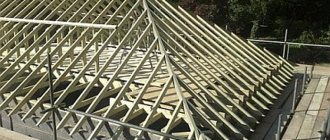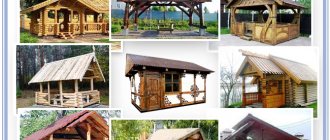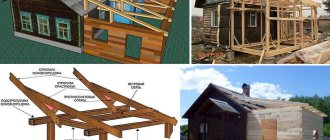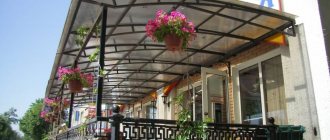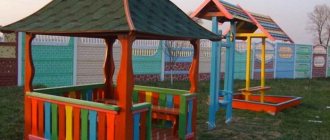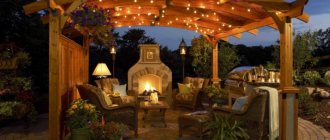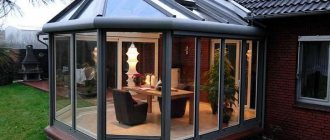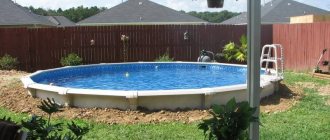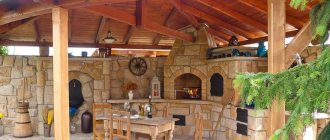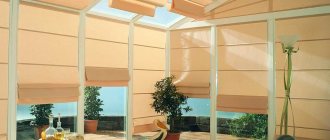Metal tiles
One of the most suitable options for extension materials is sheet metal tiles. The material has a beautiful appearance, the structure is lightweight, which is an advantage when building a gazebo.
Other advantages of building using the material include:
- environmental friendliness;
- service life - up to 20 years;
- protection from rain and snow;
- withstands temperature changes;
- ease of installation;
- it's cheap.
A roof made of sheet metal tiles looks harmonious if this material was also preferred during the construction of the roof of the house and garage. A negative nuance when building a gable roof structure for a gazebo made of sheet tiles is the need to treat it with anti-corrosion impregnation to prevent the harmful effects of moisture and noise during rain.
Criterias of choice
The roof must have a number of properties for the gazebo to last long enough. Among the main criteria for choosing a quality roof are:
- attractive appearance;
- high reliability;
- long service life;
- high quality workmanship.

In addition to the described properties, one should also take into account the harmonious combination of the roofing material and the overall design of the structure. In addition, the roof for the gazebo should look good against the background of the site and the main building.
With the right choice of coating, the design of the building will echo the design of the house. Thanks to this, the vacation spot will be unique, which will allow the owner to show his individuality. The material is also determined taking into account the type of roof. It should be not only functional, but also visually attractive.
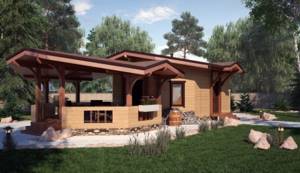
Among the many products offered on the construction market, several basic ones should be highlighted, which have many useful characteristics. To figure out how to make a gazebo roof, you should look at a short overview that will help you decide on the choice of a specific roofing covering.
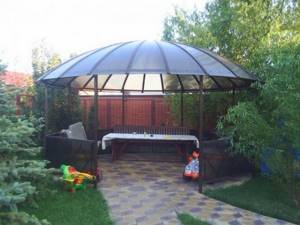
Soft tiles
When choosing a material for the roof of a gazebo, you should pay attention to soft tiles. This will be an excellent solution if the gazebo roof being installed has a complex shape. The material is quite expensive, but its characteristics justify it. Soft tiles are also called bitumen tiles, since they are made on the basis of bitumen. Among the advantages of such products are:
- ease of installation - bitumen shingles are very easy to install on the roof, since the covering fragments are small in size and flexible;
- large palette of shades;
- environmental safety for the environment - tiles do not emit harmful gases even with a significant increase in temperature;
- long service life;
- noiselessness - due to its softness, flexible tiles do not make noise during rain, which will allow people in the gazebo to relax more comfortably.

Among the disadvantages of flexible tiles are their susceptibility to breaking during strong gusts of wind, as well as the need to create a continuous base for installation.
Profiled sheet
Profiled sheets have become very popular among private developers. Different models differ in color, structure and coating. Such characteristics are selected when it is necessary to cover a structure for a specific purpose. The main difficulty when choosing a material is the need to correctly take into account its properties. When arranging the roof of the gazebo, you should pay attention to the roofing sheet. Regular models are also very popular. The wave height of such panels is about 21 mm.
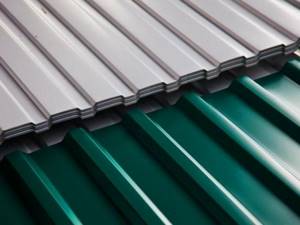
The advantages of corrugated sheets include high fire resistance. This material is not subject to combustion, and also perfectly withstands heavy loads and mechanical stress. Disadvantages include loud noise during rain and rather high installation costs. Thanks to these material characteristics, it is possible to install a barbecue in the gazebo.
Metal tiles
This material is used not only for small buildings such as gazebos. It is often used as roofing for private houses. The advantages of metal tiles include:
- ease of installation;
- low cost;
- environmental Safety;
- possibility of constructing a barbecue;
- duration of operation;
- large selection of material shades.
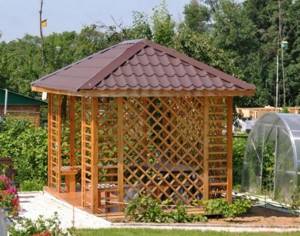
The disadvantages of metal tiles include a strong susceptibility to rust, a fairly large amount of debris during installation, as well as a high noise level during precipitation.
Slate
The material is sheet. It is made from fiberglass and cellulose. Among the advantages of the material are:
- small mass;
- a wide palette of colors offered by manufacturers;
- ease of installation;
- ease of cutting sheets;
- low price.
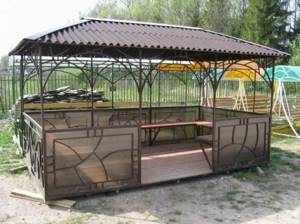
However, slate also has its drawbacks. For example, it has good moisture absorption, which promotes the appearance of fungi and lichens on the roofing. This is especially true when the gazebo is located in a shady part of the territory.
Also, when laying slate, chips may form in the places where nails are nailed. This contributes to the appearance of cracks.
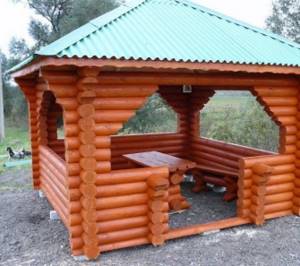
Ruberoid
Its main advantage is accessibility. The low price determines its popularity when arranging outbuildings. When installing roofing felt, no specific skills are required. The main requirement is that the sheathing must be continuous. It is made from boards or OSB boards.
The disadvantages of roofing felt include:
- short service life;
- low aesthetics.
Ruberoid can be used as a temporary covering for the roof of a gazebo. It is also used in the case of a structure that is installed only for the summer period. For these tasks, roofing felt will be an excellent solution.
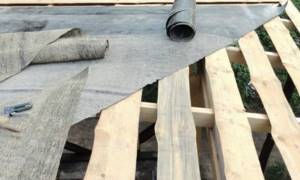
Ondulin
Like roofing felt, it has a fairly low price. It is made from cellulose and then impregnated with a special solution. The top layer is a bitumen coating. Ondulin is easy to install and has many positive properties:
- light weight;
- high degree of sound insulation;
- only 1 person may be needed for roofing work;
- the roofing base does not need to be strengthened;
- not exposed to water.
For these reasons, many owners of suburban areas choose ondulin to cover the roofs of gazebos on their site.
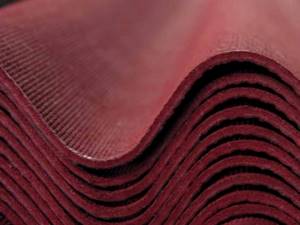
Polycarbonate
Polycarbonate is considered one of the best materials that can be used for a summer gazebo. It has quite a lot of advantages. Also, polycarbonate has virtually no disadvantages.
Attention! Polycarbonate can be used for the lightest gazebos that do not have a base and are made of wood or plastic.
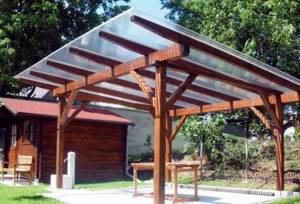
Among the advantages of polycarbonate are:
- there is no need for complex geometric calculations, because the material can be easily bent;
- due to the high plasticity of polycarbonate, gazebos of various shapes can be built;
- cutting sheets is carried out using a saw with fine teeth or a regular knife;
- it is quite cheap.
In addition, the technology for laying the coating is not very complicated. If necessary, the roof of the gazebo can be easily repaired. It is especially easy to replace some of the sheets with new ones. You can install barbecues in polycarbonate gazebos.
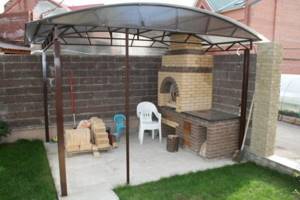
When laying polycarbonate, some features of the material should be taken into account. For example, if sheets with honeycombs are selected, they can only be bent across the stiffeners. Otherwise, the panels break easily.
Thanks to the cellular structure of polycarbonate, it has high thermal insulation properties. You can also choose a transparent material that will provide sufficient illumination to the gazebo without letting harmful ultraviolet rays through.
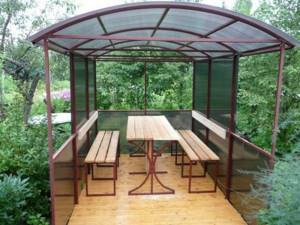
Flexible tiles
When arranging a round, hipped, hip roof structure, preference is given to soft, flexible tiles made of fiberglass treated with bitumen. Advantages of building an extension roof from this material:
- light weight;
- noiselessness;
- ease of roof installation;
- efficiency (waste-free) during the construction of a hipped or hip roof.

Among the disadvantages is the risk of deformation during windy storms.
Fire resistant roofing
If you plan to use a stove or barbecue inside the extension, it will not be possible to cover the gazebo with soft tiles: in this case, only fire-resistant material is chosen for the roof. The traditional option here is asbestos-cement slate, which is inexpensive, quick to install, and durable. It is better to replace cement-sand tiles with ceramic ones, since they are an order of magnitude lighter. A heavy roof over a gazebo will require the mandatory laying of a reliable foundation.
Profiled sheet
Another material, corrugated sheet, or corrugated sheeting, which is made from cold-rolled profile steel, is also often used for roofing.

In terms of lightness and durability, corrugated sheeting is similar to metal tiles, while corrugated sheeting is easier to use for gazebos with a hipped roof. The structure of the gazebo can easily withstand corrugated roofing.
Comparison of cost of roofing materials
Before deciding on the choice of roof for a gazebo, we recommend that you familiarize yourself with the prices of the most popular materials.
Related article: Optimal angle of a gable roof
Current prices for roofing materials:
| Name of material | Price per 1 sq. meter |
| Ondulin | RUR 254 |
| Ruberoid (roll 1×15m) | 300 RUR |
| Slate | From 160 RUR |
| Metal tiles | From 245 to 350 rub. |
| Soft tiles | From 493 RUR |
| Profiled sheet | From 285 to 400 rub. |
It is important to take into account the fact that high-quality roofing material cannot be too cheap. Otherwise, it will quickly require repair and/or replacement.
We will consider the advantages and disadvantages of each roofing material, starting with the most expensive one presented in the table, below. But first, let’s look at the characteristics of the future roof.
Ondulin
One of the popular material options, a type of slate, bitumen-based ondulin, is also often preferred when building a gazebo roof with your own hands. Advantages of ondulin:
- is cheap;
- excellent sound insulation;
- withstands temperature changes;
- ease of roof installation;
- resistance to environmental influences, durability.

Bituminous materials
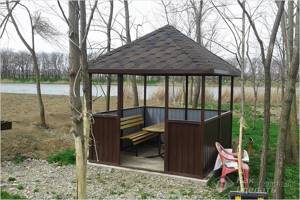
Soft tiles
Such materials are also called soft tiles. Some of them are created on the basis of metal and bitumen, and therefore combine their positive characteristics. On the outside there is a layer of basalt coating, which serves as additional protection. This material can be used for almost any type of roof, regardless of the sharpness of the slope angle. The material is sound and heat insulating and completely sealed. This is one of the best modern materials, and therefore, when choosing how to cover the roof of a gazebo, be sure to take a closer look at bitumen shingles. The disadvantages of this material include its cost, since it is slightly higher than the cost of standard corrugated sheeting or polycarbonate.
Polycarbonate
Polycarbonate is a transparent, dense, flexible sheet of plastic from which you can make a semicircular roof and the walls of a gazebo. Advantages of polycarbonate in roofing construction:
- durability;
- ease of installation during construction;
- the roof can withstand a large weight of snow (suitable for a pitched roof);
- flexibility.

Flaws:
- transparent material allows the sun to pass through;
- warms up.
Gable roof for gazebo
For a gazebo with a gable roof, a larger tilt angle is suitable - up to 60 degrees. For small buildings with a width of no more than six meters, hanging rafters will be sufficient - without central or other additional supports. The rafters should be secured from below to the mauerlats, and with the upper end to the ridge. Between the mauerlats you need to fasten the ties to prevent deformation of the entire frame, and purlins need to be installed across the rafters.
If the roof for the gazebo is more than six meters wide, then you will need to install an inclined rafter system - supported on columns. The support pillars can be located either strictly under the canopy or shifted relative to it. Additional spacers are installed on the pillars perpendicular to the rafters, taking on the weight of a large roof.
Attention!
The inside of a gable roof in a gazebo in a country house can become part of the decor of the entire building if all the wooden supports are assembled carefully and processed correctly.
Non-standard options
To add atmosphere and ethnic flavor, to build a gazebo with a canopy with your own hands, use original materials:
Living green roof
Non-standard options include a roof formed from climbing plants. Such a gazebo usually consists of a frame on which wild grapes or ivy grow upward. The gazebo creates ideal shade and coolness on hot days, but is not suitable for relaxing when it rains.
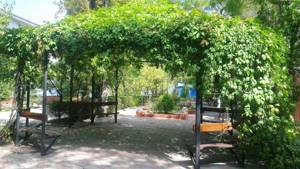
Reed
The reed roof maintains the natural theme. The material is flexible and soft, which facilitates the installation process. Reed is resistant to humidity, for which such conditions are a natural growing environment. A single-pitched or double-pitched reed roof is laid on a wooden sheathing. Among the disadvantages is the risk of deformation during windy storms.

Which roof shape do you prefer?
The simplest option is a pitched roof. Remember your childhood - these are the roofs that adorn the walking pavilions in most kindergartens in the country! Two or four ramps are also popular. A hip hip roof is very resistant to wind loads - in some regions this is so important that you have to put up with more complex installation to ensure that the roof is as reliable as possible. Hip-shaped roofs are also stable, the triangular slopes of which converge at the top into one point. Hip roofs look great on square and polygonal gazebos. The ultimate version of a hipped roof has the shape of a cone - for round arbors, sometimes there are no other options.
Hip roof structure
This is a universal design that can be easily mounted on most homestead buildings. Ease of construction, harmonious contour, extensive possibilities for stylization are convincing arguments in its favor. Among the arbors with hipped roofs, there are several varieties: hip, half-hip, hipped and Chinese - with corners bent upward. They differ in design and roofing material, as can be clearly seen in the photographs.
The construction of the roof should begin with the development of a drawing. As a rule, it is prepared in advance, along with calculations of the load on the walls and foundation - this is more practical and cheaper. Installation should be performed in the following order:
- first of all, you need to install supports around the perimeter - Mauerlats;
- then secure the corner rafters at an angle of up to 60 degrees;
- after carefully checking all the corners, fasten them to the ridge or a single peak;
- depending on the size of the building - secure intermediate rafter beams and perpendicular stiffeners - purlins;
- lay the sheathing;
- secure the roof and seal the joints.
